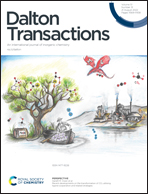NUV-pumped red-emitting Ca9MnK(PO4)7 phosphor: energy transfer and charge compensation†
Abstract
The development of novel Mn-based phosphor hosts has received increasing interest in the search for highly efficient red emitting phosphors for white LED applications. In this study, Ca9MnK(PO4)7, a compound with the β-Ca3(PO4)2-type structure, was successfully synthesized by a high-temperature solid-state reaction process. The Eu2+-doped Ca9MnK(PO4)7 phosphor exhibits a broadband red emission peaking at 650 nm. The optimal excitation wavelength is 395 nm, which matches that of commercial ultraviolet (NUV) chips. Codoping Ce3+ ions into the Ca9MnK(PO4)7:Eu2+ phosphor efficiently improves Mn2+ luminescence. Here, Ce3+ acts as a charge compensator rather than a sensitizer and substantially increases the effective number of Eu2+ and finally improves the red emission of Mn2+. The charge compensation mechanism is also verified by codoping some optically inert rare earth ions (Ln3+) including Y3+, La3+ and Gd3+. The results demonstrate that these developed Ca9MnK(PO4)7:Eu2+, Ln3+ phosphors have great potential for application in NUV-based white LEDs. The energy transfer approach combined with the charge compensation technique is valuable for improving the performance of the red-emitting Ca9MnK(PO4)7:Eu2+ phosphor, which can further be used in developing other Mn-based phosphors.



 Please wait while we load your content...
Please wait while we load your content...